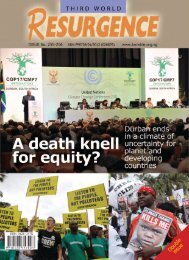Plantations, poverty and power - Critical Information Collective
Plantations, poverty and power - Critical Information Collective
Plantations, poverty and power - Critical Information Collective
Create successful ePaper yourself
Turn your PDF publications into a flip-book with our unique Google optimized e-Paper software.
74<br />
Nevertheless, pulp <strong>and</strong> paper companies rely on Pöyry’s knowledge of paper markets for information on<br />
their business decisions. “As we focus on our core business we need Pöyry’s expertise in engineering <strong>and</strong><br />
consultancy all the more,” notes Einar Agnaess of Norske Skog. “If we’re thinking about exp<strong>and</strong>ing in<br />
India, for example, they know what’s happening in the market. We simply don’t.” 367<br />
Technology “to help the environment”<br />
Dr. Jaakko Pöyry’s public statements provide a good insight into Pöyry’s role in promoting the pulp <strong>and</strong><br />
paper industry. For example, at the Financial Times World Pulp <strong>and</strong> Paper Conference in 1989, Dr. Pöyry<br />
said: “Re-establishing the image of pulp <strong>and</strong> paper as environmentally acceptable products is a<br />
necessity.” His solution did not involve considerations about the way the pulp <strong>and</strong> paper industry is<br />
structured, or an attempt to address the massive amounts of wood that the industry needs each year.<br />
Instead, his solution was the use of technology, “to help the environment”. 368 Dr. Pöyry’s firm would be<br />
happy to provide further advice on the technology. For a fee, of course.<br />
The Phoenix Pulp <strong>and</strong> Paper Company’s misnamed “Project Green” in the north-east of Thail<strong>and</strong><br />
provides one example of the sort of technology that Pöyry promotes, supposedly to “help the<br />
environment”. Project Green was designed to address the pollution from the Phoenix pulp mill, which<br />
was facing increasing criticism from local people <strong>and</strong> the Department of Industrial Works over its<br />
pollution of the Phong River. Instead of pouring the effluent into the river, Pöyry came up with “Project<br />
Green”, a scheme to use the water to irrigate eucalyptus plantations. Under “Project Green”, yellowbrown<br />
frothy water from the pulp mill is piped into irrigation channels in nearby eucalyptus plantations.<br />
From there it spreads into farmers’ adjoining fields, ruining the rice crop. When it rains heavily, the water<br />
overflows into the Phong River. The effluent seeps into the ground water. Local people complain that the<br />
water is now salty <strong>and</strong> undrinkable. When I visited the pulp mill in 1998, villagers complained that their<br />
rice harvest in fields near to Project Green had failed. 369<br />
While Pöyry sometimes acts as consultant on paper mills using recycled paper, its main area of interest is<br />
in promoting large scale pulp mills <strong>and</strong> industrial tree plantations. Pöyry lobbies behind the scenes <strong>and</strong> in<br />
public for the continued expansion of the industry. In 1995, Pöyry’s Per Jerkeman told the Financial<br />
Times that “public opinion about the desirability of recycling as much paper as possible should be<br />
changed. Utilisation of recycled fibres should be high, ‘but not so high that reforestation is diminished or<br />
prevented <strong>and</strong> paper quality impaired’.” 370<br />
Pöyry explains that the company’s technical expertise can be applied anywhere in the world, regardless of<br />
history, politics or culture:<br />
“[A]ny paper machine, in spite of sophisticated software control systems, is operating according to the<br />
same papermaking principles around the world. Papermaking is a universal art. This gives JP Operations<br />
367 Satu Jussila (2008) “Cementing partnerships”, Know-How Wire, Pöyry Client Magazine, 2/2008.<br />
368 Maggie Urry (1989) “Eastern European market beckons. Political changes open opportunities for pulp <strong>and</strong> paper<br />
makers”, Financial Times, 14 December 1989.<br />
369 Chris Lang (1998) “Phoenix pulp mill: The polluter pays” Watershed, Vol. 4 No. 2, November 1998 – February<br />
1999, page 54.<br />
370 Deborah Hargreaves (1995) “Forestry status boost forecast”, Financial Times, 26 January 1995.















